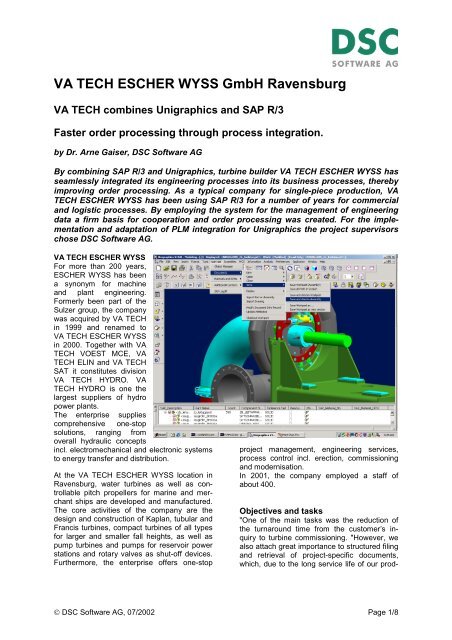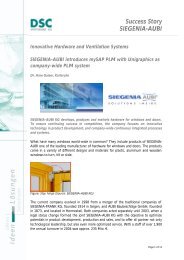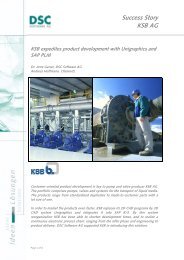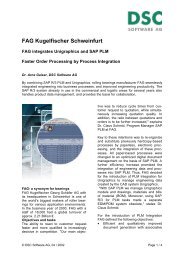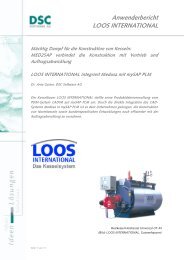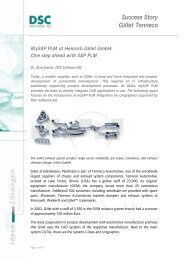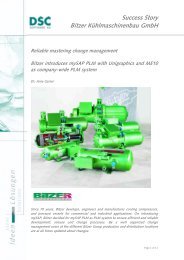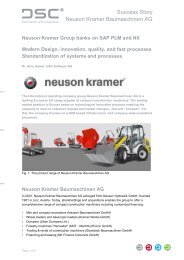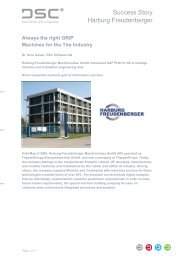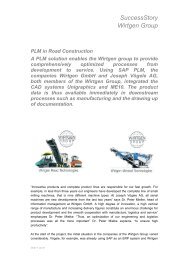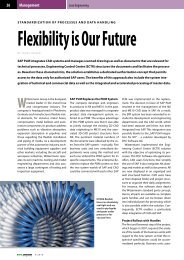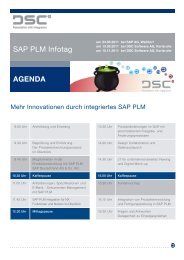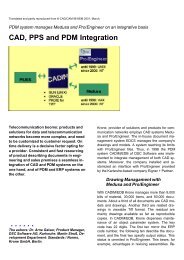VA TECH ESCHER WYSS GmbH Ravensburg - DSC Software AG
VA TECH ESCHER WYSS GmbH Ravensburg - DSC Software AG
VA TECH ESCHER WYSS GmbH Ravensburg - DSC Software AG
You also want an ePaper? Increase the reach of your titles
YUMPU automatically turns print PDFs into web optimized ePapers that Google loves.
<strong>VA</strong> <strong>TECH</strong> <strong>ESCHER</strong> <strong>WYSS</strong> <strong>GmbH</strong> <strong>Ravensburg</strong><br />
<strong>VA</strong> <strong>TECH</strong> combines Unigraphics and SAP R/3<br />
Faster order processing through process integration.<br />
by Dr. Arne Gaiser, <strong>DSC</strong> <strong>Software</strong> <strong>AG</strong><br />
By combining SAP R/3 and Unigraphics, turbine builder <strong>VA</strong> <strong>TECH</strong> <strong>ESCHER</strong> <strong>WYSS</strong> has<br />
seamlessly integrated its engineering processes into its business processes, thereby<br />
improving order processing. As a typical company for single-piece production, <strong>VA</strong><br />
<strong>TECH</strong> <strong>ESCHER</strong> <strong>WYSS</strong> has been using SAP R/3 for a number of years for commercial<br />
and logistic processes. By employing the system for the management of engineering<br />
data a firm basis for cooperation and order processing was created. For the implementation<br />
and adaptation of PLM integration for Unigraphics the project supervisors<br />
chose <strong>DSC</strong> <strong>Software</strong> <strong>AG</strong>.<br />
<strong>VA</strong> <strong>TECH</strong> <strong>ESCHER</strong> <strong>WYSS</strong><br />
For more than 200 years,<br />
<strong>ESCHER</strong> <strong>WYSS</strong> has been<br />
a synonym for machine<br />
and plant engineering.<br />
Formerly been part of the<br />
Sulzer group, the company<br />
was acquired by <strong>VA</strong> <strong>TECH</strong><br />
in 1999 and renamed to<br />
<strong>VA</strong> <strong>TECH</strong> <strong>ESCHER</strong> <strong>WYSS</strong><br />
in 2000. Together with <strong>VA</strong><br />
<strong>TECH</strong> VOEST MCE, <strong>VA</strong><br />
<strong>TECH</strong> ELIN and <strong>VA</strong> <strong>TECH</strong><br />
SAT it constitutes division<br />
<strong>VA</strong> <strong>TECH</strong> HYDRO. <strong>VA</strong><br />
<strong>TECH</strong> HYDRO is one the<br />
largest suppliers of hydro<br />
power plants.<br />
The enterprise supplies<br />
comprehensive one-stop<br />
solutions, ranging from<br />
overall hydraulic concepts<br />
incl. electromechanical and electronic systems<br />
to energy transfer and distribution.<br />
At the <strong>VA</strong> <strong>TECH</strong> <strong>ESCHER</strong> <strong>WYSS</strong> location in<br />
<strong>Ravensburg</strong>, water turbines as well as controllable<br />
pitch propellers for marine and merchant<br />
ships are developed and manufactured.<br />
The core activities of the company are the<br />
design and construction of Kaplan, tubular and<br />
Francis turbines, compact turbines of all types<br />
for larger and smaller fall heights, as well as<br />
pump turbines and pumps for reservoir power<br />
stations and rotary valves as shut-off devices.<br />
Furthermore, the enterprise offers one-stop<br />
project management, engineering services,<br />
process control incl. erection, commissioning<br />
and modernisation.<br />
In 2001, the company employed a staff of<br />
about 400.<br />
Objectives and tasks<br />
"One of the main tasks was the reduction of<br />
the turnaround time from the customer’s inquiry<br />
to turbine commissioning. "However, we<br />
also attach great importance to structured filing<br />
and retrieval of project-specific documents,<br />
which, due to the long service life of our prod-<br />
© <strong>DSC</strong> <strong>Software</strong> <strong>AG</strong>, 07/2002 Page 1/8
ucts, may be required even a long time later"<br />
says Gerhard Brehm, head of IT at <strong>VA</strong> <strong>TECH</strong><br />
<strong>ESCHER</strong> <strong>WYSS</strong>.<br />
"This requires aggregate-oriented methods of<br />
design, early integration of logistic processes<br />
and a transparent way of following modification<br />
processes. Digital integration of design processes<br />
into our business processes was a necessary<br />
precondition in pursuing this objective.<br />
It allows for better planning of long-term contracts<br />
and, through reutilization of existing design<br />
documents, for the sales department<br />
gaining faster access", adds Hans-Ulrich<br />
Günther, Constructive Development at <strong>VA</strong><br />
<strong>TECH</strong> <strong>ESCHER</strong> <strong>WYSS</strong>.<br />
In order to achieve these objects, <strong>VA</strong> <strong>TECH</strong><br />
decided on SAP as PLM system and on PLM<br />
integration for Unigraphics to manage engineering<br />
date compiled by means of the CAD<br />
system Unigraphics.<br />
"We use SAP to process all our orders. Contracts<br />
and design worksheets form one unit. To<br />
extend SAP also for the management of our<br />
Unigraphics models and drawings is only logical",<br />
explains Gerhard Brehm.<br />
"Moreover, via PLM integration, we can also<br />
use all applicable settings at <strong>VA</strong> <strong>TECH</strong> with<br />
regard to master data management, SAP classification,<br />
user and authorization concept and<br />
data archiving.<br />
The integration of Unigraphis into SAP R/3 to<br />
us means taking another step towards a complete<br />
PLM system".<br />
By introducing PLM integration for Unigraphics<br />
the following objectives were pursued:<br />
• Improved handling of customer projects<br />
• Reduction of turnaround time for design<br />
contracts from the customer's inquiry to the<br />
release of the construction documents.<br />
• Management of all product-specific data<br />
and documents in SAP R/3 in accordance<br />
with ISO 9001.<br />
• Improved cooperation and transparency<br />
for design processes.<br />
• Automatized and controlled release and<br />
modification processes<br />
• Improved reuse of existing design documents<br />
• Safety and authorization concept provided<br />
by R/3<br />
• Company-wide access to design documents<br />
These objectives were to be achieved by direct<br />
and in-depth integration of development processes,<br />
product data, documents and structures<br />
into SAP PLM.<br />
The situation<br />
Currently, both Unigraphics and the predecessor<br />
system Helix are used in parallel at <strong>VA</strong><br />
<strong>TECH</strong> <strong>ESCHER</strong> <strong>WYSS</strong>. Unigraphics is the<br />
strategic design program in the group. Step by<br />
step, it is replacing the 2D-CAD system Helix.<br />
The decision to use Unigraphics proved to be<br />
advantageous even after the acquisition by the<br />
<strong>VA</strong> <strong>TECH</strong> group, as <strong>VA</strong> <strong>TECH</strong>, too uses the<br />
3D system Unigraphics and both IT landscapes<br />
match.<br />
In 2000, various PLM systems were evaluated.<br />
"It turned out that the central criterion was the<br />
ability to link design, contract and project data<br />
supplied by SAP R/3 with other documents,<br />
such as drawings, parts lists, correspondence,<br />
etc.<br />
Today, the SAP system is already is use for<br />
any task in the field of logistics, commercial<br />
transactions and procurement," reports<br />
Gerhard Brehm.<br />
Project management<br />
<strong>DSC</strong> <strong>Software</strong> <strong>AG</strong> was entrusted with the implementation<br />
and customization of PLM integration<br />
for Unigraphics. This was done in two<br />
steps.<br />
In summer 2001, the first step was to launch a<br />
pilot project for PLM integration for Unigraphics.<br />
Specific processes were selected and the<br />
users trained. In time and content, this phase<br />
was closely connected to the company-wide<br />
introduction of Unigraphics. The important<br />
thing was that the design engineers, from the<br />
very beginning, managed their CAD data in<br />
SAP.<br />
The second step was the introduction of a<br />
modification process and a process for the<br />
creation of TIFF files. In January 2002, the pilot<br />
project was turned into a fully operational system<br />
for production.<br />
CAD integration was to meet the following<br />
requirements:<br />
© <strong>DSC</strong> <strong>Software</strong> <strong>AG</strong>, 07/2002 Page 2 / 8
• Utilization of existing master<br />
data supplied by SAP<br />
• Creation of document info records<br />
in SAP R/3 using the 3D<br />
components and subassemblies<br />
incl. drawing creation<br />
in SAP R/3. In SAP R/3<br />
the necessary meta data and<br />
files are created and managed<br />
via the interface only.<br />
• Structuring of document info<br />
records, material master records<br />
as well as further object<br />
links.<br />
• Safe version management of<br />
documents.<br />
• Secure transfer of SAP data to<br />
drawing title blocks.<br />
• Process-controlled creation of<br />
TIFF files suitable for archiving<br />
and viewing with a viewer.<br />
• Utilization of the SAP user and<br />
user authorization concept.<br />
Document-oriented approach<br />
PLM integration for Unigraphics means that<br />
Unigraphics data are incorporated into the <strong>VA</strong><br />
<strong>TECH</strong> processes so as to provide for a process<br />
or document-oriented approach. Unigraphics<br />
models and drawings are consistently<br />
managed by the R/3 document management<br />
system. Based on Unigraphics, the following<br />
document management functions are available:<br />
• Creating a new document<br />
• Finding/Opening a document from R/3 for<br />
display/editing<br />
• Saving a document<br />
• Modifying a document info record<br />
• Displaying a document info record<br />
• Displaying a document: write-protected<br />
opening of the original document or viewing<br />
of a TIFF/VRML file<br />
• Display of document info<br />
• Display of the product structure using the<br />
SAP Product Structure Browser<br />
• Importing documents<br />
• Status management / Versioning<br />
Every component, sub-assembly and drawing<br />
is represented as SAP document in R/3. A<br />
SAP document consists of two components:<br />
the original Unigraphics CAD file and the<br />
pertaining document description (document<br />
info record). A document info record consists<br />
of an unambiguous document key, administrative<br />
data and information about the original<br />
document. The document key consists of<br />
document number, document type, document<br />
part and document version.<br />
For fast and authorized access to and control<br />
of specific processes separate document types<br />
were devised: three types of documents for<br />
models and 15 types of documents for drawings<br />
(see illustration).<br />
Models:<br />
HZ1 UG Model Sub-Assembly<br />
HZ2 UG Model Individual Component<br />
HZ3 UG Standard Component<br />
(BCT)<br />
Drawings:<br />
HZA Overall assembly drawing<br />
HZB Sub-assembly drawing<br />
HZC Constructional, erection plans<br />
HZD Hydraulic profiles<br />
HZE Individual components / Parts<br />
lists<br />
HZN Constructional drawings<br />
HZO General project drawing<br />
HZP Project drawing Power House<br />
HZQ Auxiliary drawings<br />
The designer creates the document info record<br />
for the corresponding document for the proc-<br />
© <strong>DSC</strong> <strong>Software</strong> <strong>AG</strong>, 07/2002 Page 3 / 8
ess. Later on, he creates<br />
the corresponding material<br />
master record or assigns<br />
the drawing to the corresponding<br />
material and links<br />
it to the pertaining documents.<br />
Every document<br />
type is split up into classes.<br />
At the early stages of data<br />
acquisition, the designer<br />
classifies the corresponding<br />
characteristics. The<br />
classification system created<br />
on the document level<br />
in SAP by <strong>VA</strong> <strong>TECH</strong> is<br />
used for organising parts,<br />
sub-assemblies and drawings<br />
and serves for a fast<br />
access to and retrieval of<br />
components and documents,<br />
and for searching<br />
for similar and reusable<br />
components. In addition to this, designers can<br />
also use document selection in the Object<br />
Manager of PLM Integration.<br />
PLM Integration for Unigraphics ensures that<br />
Unigraphics models and drawings are securely<br />
filed in the electronic safe (vault) of R/3.<br />
Management of structures<br />
The design department creates document<br />
master records for all components, material<br />
master records, however, only for assembly<br />
drawings.<br />
To allow unambiguous allocation of documents<br />
to the final product, the material master record<br />
is linked to the project drawing and the assembly<br />
drawing for production. Via a menu item of<br />
PLM Integration, an object link for the active<br />
component in Unigraphics can automatically<br />
and directly be created in SAP PLM.<br />
In the R/3 system Unigraphics sub-assembly<br />
structures are represented as document<br />
structures. Unigraphics stores every individual<br />
component and every assembly in a separate<br />
file. Component files contain CAD geometries,<br />
sub-assembly files the references to pertaining<br />
components and sub-assemblies. The document<br />
parts list is automatically created and<br />
maintained by the Unigraphics-SAP interface<br />
in SAP. Once a sub-assembly is modified in<br />
Unigraphics, the document structure linked to it<br />
is automatically updated when saving it in<br />
SAP. The SAP Product Structure Browser can<br />
be used for displaying the product structure.<br />
The Product Structure Browser breaks up the<br />
document references and groups the referenced<br />
objects so as to provide a quick overview.<br />
The Product Structure Browser allows all<br />
required documents incl. their versions, drawings<br />
and material links to be displayed at one<br />
glance.<br />
Folders and Favourites<br />
The Object Manager is available to designers.<br />
It is the central information cockpit for R/3<br />
object management. It provides a structured<br />
and up-to-date overview of projects/products<br />
and R/3 objects contained therein, such as<br />
documents and materials. The Object Manager<br />
allows fast navigation through the data records,<br />
facilitates retrieval of data objects and<br />
allows direct access to the R/3 objects in which<br />
an interest is taken. This interface allows operations<br />
to be performed on marked R/3 objects,<br />
e.g. modifying, displaying or shifting (reclassifying)<br />
of objects.<br />
Drawings management<br />
Great emphasis is placed on efficient drawings<br />
management. <strong>VA</strong> <strong>TECH</strong> put forward the following<br />
demands:<br />
© <strong>DSC</strong> <strong>Software</strong> <strong>AG</strong>, 07/2002 Page 4 / 8
• Automatic transfer of current information<br />
from document info record, material<br />
master record and classification to<br />
the title block of a drawing.<br />
• Display of modification history on the<br />
drawing. The last five modification<br />
steps are to be displayed in the title<br />
block.<br />
• Automatic creation of a TIFF file to be<br />
archived and viewed in combination<br />
with release strategy and management<br />
in SAP.<br />
• Company-wide access to TIFF files for<br />
users without CAD system.<br />
To produce the drawings, <strong>VA</strong> <strong>TECH</strong> uses<br />
the software UG/Tools. To accelerate the<br />
production of drawings <strong>VA</strong> <strong>TECH</strong> prepared<br />
certain templates for frames and title<br />
blocks. The drawing template contains all<br />
important settings, such as the frame layout,<br />
the margin settings, layer, colour and<br />
line settings and the title block attributes. A<br />
drawing is created just like a document info<br />
record for a model.<br />
For drawings, various document types are<br />
available, depending on the application.<br />
Automatic transfer of information to the<br />
title block of a drawing<br />
Models and derived drawings are managed<br />
directly in SAP, which means that the modifications<br />
can be handled uniformly and transparently<br />
on a company-wide basis. Via PLM<br />
integration, meta data, such as title, document<br />
number, version, material and modification<br />
history are directly transferred to the title block<br />
of the Unigraphics drawing. When a drawing is<br />
created or the pertaining meta data are modified,<br />
the title block is updated. "All data relevant<br />
for the drawings are provided by SAP as<br />
the leading system. The automatic transfer of<br />
information to the title block ensures consistent<br />
management of design data. This also led to a<br />
considerable reduction of expenditure for<br />
maintenance of drawings", stresses Gerhard<br />
Brehm.<br />
Visualization of<br />
CAD drawings<br />
on every workplace<br />
The turbines produced<br />
by <strong>VA</strong> <strong>TECH</strong><br />
frequently are in<br />
operation for more<br />
than 20 years. This<br />
means that the requirements<br />
as to<br />
archiving / reproduction<br />
are very<br />
high and that archive<br />
files must be<br />
prepared for every<br />
drawing created by<br />
© <strong>DSC</strong> <strong>Software</strong> <strong>AG</strong>, 07/2002 Page 5 / 8
CAD. <strong>VA</strong> <strong>TECH</strong> uses the TIFF format for this<br />
purpose.<br />
Moreover, this TIFF format allows users<br />
prompt access to the latest drawings without<br />
using the Unigraphics software. Creation of<br />
TIFF files is incorporated in a release process<br />
and is the result of status modifications. The<br />
TIFF file is then saved under the same document<br />
info record as the original Unigraphics<br />
drawing.<br />
Release and modification strategies<br />
In the course of order processing, data and<br />
information is often adapted and modified. So<br />
as to provide unambiguous proof of "verifier",<br />
"date of verification", "releasing person" and<br />
"date of release" – even within the scope of<br />
product liability – this information is noted<br />
down on the drawing. Formerly, the staff was<br />
ultimately responsible for drawing up the <strong>VA</strong><br />
<strong>TECH</strong> guidelines for controlling, verifying and<br />
approving drawings and documents as well as<br />
for checking compliance with them. After introducing<br />
PLM integration for Unigraphics, the<br />
SAP system and the processes selected<br />
therein have become responsible for compliance<br />
with certain release<br />
procedures. This means<br />
that the procedures remain<br />
reproducible and comprehensible.<br />
The solution to this problem<br />
was a combined updating<br />
and TIFF file creation<br />
process that is automatically<br />
started at particular<br />
status transfers. For<br />
this purpose a status network<br />
was introduced as the<br />
basis for all document<br />
types. It determines the<br />
positions the document is<br />
to run through prior to its<br />
release and who is entitled<br />
to a status change. Verifications,<br />
approvals and<br />
releases can only be performed<br />
by people authorized<br />
to do so. Altogether 5<br />
release strategies were defined and a release<br />
strategy assigned to each of the 15 types of<br />
documents.<br />
Abbr. Meaning Procedure<br />
AA Work request<br />
IA In work<br />
ZU Accessible<br />
SZ Lock – accessible<br />
EF Released by origi- TIFF file creanatortion<br />
PT Verified - Engi- TIFF file creaneeringtion<br />
PA Verified - Order TIFF file crea-<br />
processing tion<br />
GE Approved TIFF file creation<br />
FR Released<br />
SS Lock release<br />
ZG Rejected<br />
For documents HZG (auxiliary drawings) only a<br />
release by the originator is required. There are<br />
no further verifications and approvals. For<br />
documents type HZN (design drawings), however,<br />
the requirements are more comprehensive:<br />
Here both verification and approval by the<br />
Engineering Department as well as verification<br />
by the group manager or the head of the department<br />
are required. The drawing can only<br />
be released by the segment leader.<br />
Illustration: Status network / Release strategy<br />
for document types - Auxiliary drawings<br />
(above) and Design drawings (below)<br />
© <strong>DSC</strong> <strong>Software</strong> <strong>AG</strong>, 07/2002 Page 6 / 8
Creation of the TIFF file is included in the release<br />
process. Before producing the TIFF file,<br />
title block and modification history of the original<br />
Unigraphics drawing are updated. This is<br />
necessary to ensure that the current modification<br />
history is also included in the TIFF file<br />
used for archiving, reproduction and display<br />
purposes all over the company.<br />
When changing over to status EF (originator<br />
release), PT (verfied, Engineering), PA (verified,<br />
processing) and GE (Approved) the updating<br />
and TIFF file creation process is started<br />
by a user exit and is run automatically in the<br />
background as separate process on a separate<br />
server. Changeover to the release status<br />
is automatically performed by the process<br />
based on the status "approved".<br />
When changing the status, a programme is<br />
executed first of all, which calls up the required<br />
function modules in the R/3 system for the<br />
modification history and for retrieving and saving<br />
the drawing files and which prepares the<br />
data of previous versions. The programme<br />
ensures that title block and modification history<br />
on the drawing are updated. In the original<br />
version, the modification history remains<br />
empty. In the course of the release procedure,<br />
which is dependent on the corresponding type<br />
of document, the lines and fields provided for<br />
modifications are gradually filled with information.<br />
When creating<br />
a new document<br />
version –<br />
which does not<br />
necessarily include<br />
a release – the<br />
corresponding next<br />
line is filled. Only<br />
the five last modification<br />
stages and<br />
their verification,<br />
approval and release<br />
statuses are<br />
displayed on the<br />
drawing, starting<br />
with the current<br />
version and going<br />
back up to four<br />
previous versions,<br />
if applicable. The<br />
data required for<br />
this purpose are<br />
read from the pertaining<br />
document<br />
info records in the R/3 system and are transferred<br />
to the drawing via the attribute assignment<br />
available in Unigraphics.<br />
Following this, the process creates individual<br />
postscript files, sheet by sheet, of the drawing<br />
by sending the original Unigraphics drawing to<br />
a Unigraphics plot queue set up for this process.<br />
The Postscript files produced thus are<br />
then converted into TIFF format by the programme<br />
Ghostscript. If several sheets are<br />
produced from one drawing, the process<br />
automatically creates a multipage TIFF file.<br />
In SAP R/3, version 4.5 the TIFF file is saved<br />
as file 2 under the same document info record<br />
as the original Unigraphics drawing managed<br />
as file 1.<br />
To display the TIFF files, the external operating<br />
system viewer, Wang Imaging, is available<br />
company-wide.<br />
By automatising this process, <strong>VA</strong> <strong>TECH</strong> has<br />
been able to considerably reduce the turnaround<br />
time for offer and order processing!<br />
Cooperation with external engineering<br />
companies<br />
Cooperation with external engineering offices<br />
plays an important role. Many contractors re-<br />
© <strong>DSC</strong> <strong>Software</strong> <strong>AG</strong>, 07/2002 Page 7 / 8
quest 3D draft drawings at an early stage of<br />
the project; non- or late compliance with this<br />
request often results in a penalty being imposed.<br />
This is why time-consuming layouts<br />
ready for detailing are outsourced to external<br />
engineering companies.<br />
So as to provide for an efficient exchange of<br />
data with external companies, the standard<br />
import functionality provided by PLM integration<br />
for Unigraphics was extended.<br />
This import function takes three basic situations<br />
into account:<br />
• Very often, document info records have<br />
already been created in SAP, with the<br />
drawing, however, not being available.<br />
This is a typical situation for drawings produced<br />
by Helix. These 2D drawings by Helix,<br />
which are not consistent with master<br />
models, can be transferred to Unigraphics<br />
via data transfer and be archived with an<br />
existing document info record via the import<br />
function.<br />
• Furthermore, Unigraphics drawings with a<br />
3D model can be incorporated.<br />
• In addition to this, complex Unigraphics<br />
assembly structures with nested subassemblies<br />
and derived drawing models<br />
can be imported.<br />
For import, numerous verification functions<br />
have been implemented to ensure and verify if<br />
a model or drawing already exists, i.e. whether<br />
there is a document info record or an original.<br />
When importing, the user can decide whether<br />
an existing document is to be overwritten or to<br />
be stored as a new version or under a different<br />
document info record. A user interface helps<br />
taking decisions. For more complex structures,<br />
the references are also updated during the<br />
import.<br />
This import function allows a real integration<br />
into the SAP document management system. It<br />
takes the document types, the status flow and<br />
the authorization concepts defined by <strong>VA</strong><br />
<strong>TECH</strong> into consideration.<br />
Currently <strong>VA</strong> <strong>TECH</strong> is examining whether the<br />
external engineering companies mentioned<br />
above can be directly integrated into the PLM<br />
process.<br />
Prospects<br />
The experience we have gained with PLM<br />
integration is most promising: "In addition to<br />
tighter business process integration and the<br />
cost reductions connected with this, it’s the<br />
verified and readily accessibly product data<br />
that are highly appreciated", says Gerhard<br />
Brehm. "We have reached our objective to<br />
manage all product-specific date uniformly in<br />
R/3. From engineering to distribution our business<br />
processes are now highly integrated.<br />
And, what’s more, we have also succeeded in<br />
boosting productivity."<br />
Contact:<br />
Dr. Arne Gaiser<br />
<strong>DSC</strong> <strong>Software</strong> <strong>AG</strong><br />
Am Sandfeld 17<br />
76149 Karlsruhe<br />
0721/9774-148<br />
www.dscsag.de<br />
© <strong>DSC</strong> <strong>Software</strong> <strong>AG</strong>, 07/2002 Page 8 / 8


